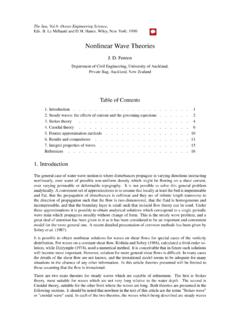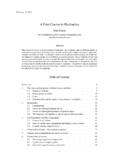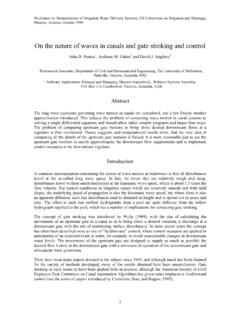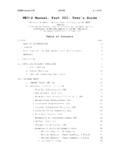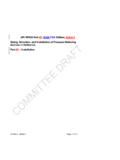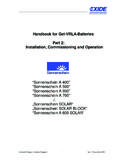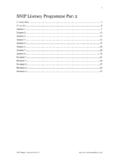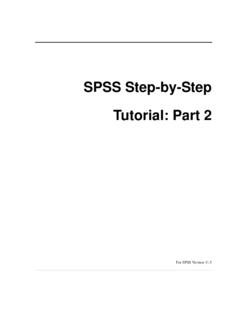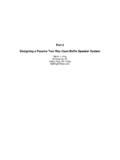Transcription of Rating Curves: Part 2 – Representation and Approximation
1 The Institution of Engineers, Australia Conference on Hydraulics in Civil Engineering Hobart 28 30 November 2001, pp 319-328. Rating curves : part 2 Representation and Approximation J. D. Fenton , , , Professorial Fellow, Department of Civil and Environmental Engineering, The University of Melbourne, Victoria, Australia 3010. Work performed at the Cooperative Research Centre for Catchment Hydrology, Department of Civil Engineering, PO Box 60, Monash University, Victoria, Australia 3800. Abstract: A Rating curve represents a supposedly-unique relationship between the stage (surface elevation) of water at a gauging station and the flow past that station.
2 A significant problem is that the flow can vary from none to that of large floods, and this whole range has to be represented, including everyday small flows. A. traditional way of doing this is to use log-log axes, but these have a number of problems. This paper considers the simple hydraulics of typical natural geometries of controls and river cross-sections and shows that in many situations the stage at the gauging station will vary roughly like the square root of the discharge, but with different relationships at different flow ranges. This suggests routinely plotting stage against the square root of discharge as representing and approximating Rating curves .
3 Keywords:. discharge, flood, flow, gauging, hydrograph, plotting, Rating curve, river. 1 INTRODUCTION. In the introduction to the companion paper to this one (Fenton, 2001) the nature of Rating curves was described, including the comment by Brown, quoted by Chester (1986), who called for the need to examine and "rationalise the whole question of discharge Rating curves " as it "has received relatively little attention in technical literature". and "is covered in a general fashion in the stream gauging manuals". In the companion paper it was remarked that since 1983 there has been little progress along those suggested directions.
4 The companion paper provided a summary of one part of the report by Fenton and Keller (2001), this paper deals with another aspect how they might be plotted and approximated. This uses some elementary hydraulics to guide the path. The idea of plotting a fractional power of discharge was first put forward by Chester (1986), who advocated plotting discharge to the power , which has been implemented in some practical software. In this paper it is suggested that is to be preferred, as it is more representative of the hydraulics and natural features of rivers and controls. Thus, it is advocated that one actually plots on ( Q , ) axes.
5 2 LOGARITHMIC SCALES. A problem with Rating curves is that they have to represent a relationship between stage, which might vary by 10. metres or so, and discharge which can vary by several orders of magnitude, from 0 to hundreds of thousands of discharge units. A traditional solution is to plot the discharge using a logarithmic scale, effectively expanding the region for small flows and contracting that for large. In many books and standards (for example, Herschy, 1995, and Australian Standard AS , 1990) it is shown how it is convenient to use a logarithmic scale for the stage as well, in that often it is found that that by subtracting of some arbitrary value 0 such that if one plots the logarithm of the discharge against the logarithm of 0 , points on the Rating curve approximately fall on a straight line.
6 The implication of this is that the discharge obeys a law of the form Q = C ( 0 )n , (1). where C and n are constants. Such a relationship might be valid for low flow, and there might even be a similar but different relationship for high flows. To handle this more complicated situation, the curve could be broken up into a small number of segments, each of which is a straight line on the log-log plot, such as performed by 319. Rating curves : part 2 Representation and Approximation John D. Fenton Herschy, (1995, # ). This does seem a rather arbitrary procedure, however. Rather better would be to approximate it with a larger number of such segments, when the use of straight-line Approximation would be sound.
7 This is widely done in practice. Generally, however, the use of log-log plots is fraught with difficulties, and the continuing and enthusiastic advocacy of their use in texts and standards is surprising. Some of the difficulties include The cease-to-flow point, actually just (0, 0 ) , cannot be shown on a log-log plot, as on those axes it is at a horizontal position of ( , ) . This is not necessarily an important disadvantage. The important problem is that the cease-to-flow point needs to be found before plotting the figure, by the following method. The cease-to-flow point can be found by a nonlinear analytical procedure involving the use of three data points at which values for and Q are known, and substituting into a formula for 0 (see, for example # of Herschy, 1995).
8 While this is a relatively simple method, it is not clear that it is safe to advise it as a technique for routine practice. The method depends on choosing three points deemed to satisfy (1) exactly. There is no room for a recognition that it would be better to incorporate more data points in a least-squares sense. The formula given is badly conditioned if n 1 , and breaks down completely if n = 1 . Subsequently least-squares methods can be used to find values of C and n. The log-log plot allows for this in a linear sense, for taking the logarithm of both sides of (1) gives log Q = log C + n log( 0 ) , and by using log Q and log( 0 ) the solution follows by standard methods.
9 For small flows and heads the data points are artificially separated, and small differences physically become large differences with a tendency to attach more importance to these points in the least squares procedure than is really the case. For large flows, the reverse holds, and the points are compressed, large differences are apparently compressed, and the points are rendered less important. One disadvantage is that the use of log-log scales is open to misinterpretation and abuse. In one hydrographic office an elementary misunderstanding has lead to a plotting mistake being made which rendered all points incorrectly plotted, although this was only of any consequence only at the low-flow end.
10 In a similar spirit to this is the observation of the quite ubiquitous use of a plot of the logarithm of the stage as simply log , where the stage is relative to an arbitrary datum, rather than the plotting the logarithm of the stage relative to the cease-to-flow stage, log( 0 ) . There is no theoretical justification for plotting log ; even if the stage discharge relationship were exactly as given by (1) it would not plot as a straight line on log Q - log axes. Figure of Herschy shows how this is the case. Stage (m). 0 1 10 100 1000 10000 100000 1000000. Discharge (Ml/d). Figure 1. Stage-discharge Relationship Using Log-log Axes for Pallamallawa on the Gwydir River, with a Line of Best Fit on These Axes to All but the Last Two Points 320.
